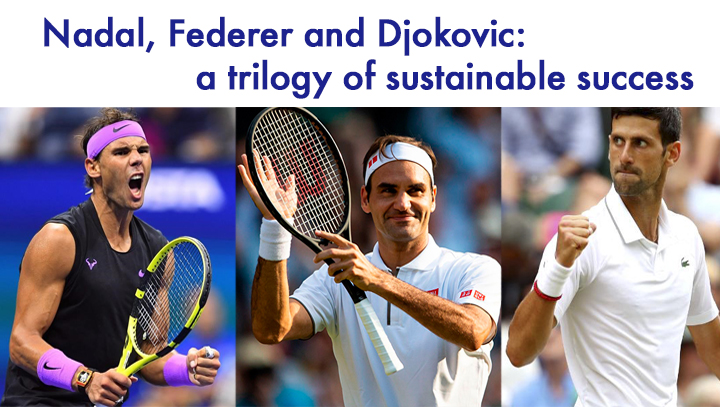Elite sport is a great laboratory to detect the keys to sustainable professional success. An analysis of the best athletes in history shows that staying at the highest level in the long term (more than 5 years) is very rare.
Many reasons can explain it, I highlight two of them:
a) it is very difficult to maintain the hunger for victory and continuous improvement when you are the greatest for years and,
b) competitors do not rest and have a motivation plus to unseat the best. For this they strive to improve to the smallest details. Subtle aspects that make the difference between winning and losing.
The current tennis competition contains an interesting enigma:
What are the reasons why Nadal, Federer and Djokovic have dominated world tennis for the past 15 years (2005-2019)?
With the recent and great victory of Nadal in the Open USA among the three of them have won 51 Grand Slams of the 60 celebrated in that period: an impressive 85% of the total.
An achievement that goes beyond tennis and from which to draw deep lessons for the company, talent management or education.
How is it possible that the new tennis talent can’t defeat these 3 veterans who are over 30 years old? Is it perhaps lack of good tennis, physical strength or lack of ambition?
My analysis is that the new generations of tennis players fail to combine the “trilogy” of sustainable success at the highest level:
- Talent: Some young tennis players are tremendously bright and eager to succeed and impose their law. His technique and fitness are spectacular. A magnificent base but not enough to win big and close matches that usually last more than 4 hours.
- Sacrifice: Knowing how to suffer, accepting adversity, always endure a little more, ensuring that the hand does not tremble in decisive plays. Key aspects in which the three champions make a difference.
As Toni Nadal (former Rafa Nadal coach) says “today training methods facilitated everything in excess and this weakens. We have been too condescending with the new generations. Veterans never give up because they were taught not to complain. ”
This overprotection of talent has hurt younger players, unable to break the “glass ceiling” that separates the victory of good play in big tournaments. - Values: The sacrifice is not enough if it is not accompanied by passion, commitment, rigor and symbiosis between the player and his coaching staff. And I highlight humility as another differential element.
Humility to keep the “head cold” after repeated accomplishments and continue listening to others. To enjoy victory and keep intact the spirit of overcoming. To dose the tournaments played annually and thus prolong his career.
Some time ago I was lucky to see Rafa Nadal play live. What impressed me most was not his obvious great tennis and fitness. The most shocking was his charisma of champion, sportsmanship and the combination of “fire in his eyes” and temperance in key plays.
A serenity grown over low heat during training hours. A mental strength that, as just demonstrated again, unbalances the results in its favor, especially in the most even matches.
In today’s competitive world, these players demonstrate that victory is achieved with fidelity to their own style and wisely combining the rational (technique, knowledge, experience or resources) with the emotional (self-confidence, intuition, resilience or passion).
Nadal, Federer and Djokovic: three ways to play, three ways to beat and yet a common winning combination: talent, sacrifice and values.
This article has also been published in ‘Expansión –Go to the article–
David Reyero Trapiello – Senior HR Business Partner – Sanofi Iberia
e-mail: David.reyero@sanofi.com / Twitter: @davidreyero73 / Linkedin: linkedin.com/in/davidreyerotrapiello/

Leave a Reply